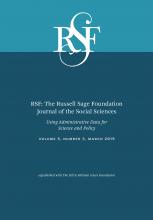Research Article
Open Access
Civil Society Goes to School: Parent-Teacher Associations and the Equality of Educational Opportunity
Brittany Murray, Thurston Domina, Linda Renzulli, Rebecca Boylan
RSF: The Russell Sage Foundation Journal of the Social Sciences March 2019, 5 (3) 41-63; DOI: https://doi.org/10.7758/RSF.2019.5.3.03
Brittany Murray
aDoctoral student in the School of Education at the University of North Carolina at Chapel Hill
Thurston Domina
bAssociate professor of educational policy and sociology in the School of Education at the University of North Carolina at Chapel Hill
Linda Renzulli
cProfessor of sociology and department head in the College of Liberal Arts Department of Sociology at Purdue University
Rebecca Boylan
dPostdoctoral researcher in the College of Liberal Arts Department of Sociology at Purdue University

REFERENCES
- ↵
- Alesina, Alberto, and
- Eliana La Ferrara
- ↵
- Andrews, Rhys
- ↵
- Blau, Peter M
- ↵
- Brown, Catherine,
- Scott Sargrad, and
- Meg Benner
- ↵
- Bryk, Anthony S
- ↵
- Bryk, Anthony S., and
- Barbara Schneider
- ↵
- Bryk, Anthony S.,
- Penny Bender Sebring,
- Elaine Allensworth,
- John Q. Easton, and
- Stuart Luppescu
- ↵
- ↵
- Calarco, Jessica M
- ↵
- Chetty, Raj,
- John N. Friedman,
- Emmanuel Saez,
- Nicholas Turner, and
- Danny Yagan
- ↵
- Chua, Amy
- ↵
- ↵
- Comer, James P
- ↵
- ↵
- Crawford, Susan, and
- Peggy Levitt
- ↵
- Cucchiara, Maia B
- ↵
- ↵
- Currid-Halkett, Elizabeth
- ↵
- Dee, Thomas
- ↵
- Domina, Thurston
- ↵
- Domina, Thurston,
- Andrew McEachin,
- Paul Hanselman,
- Priyanka Agarwal,
- NaYoung Hwang, and
- Ryan Lewis
- ↵
- ↵
- Duncan, Greg J., and
- Richard J. Murnane
- ↵
- Epstein, Joyce L
- ↵
- ↵
- Hallett, Tim
- ↵
- Hanushek, Eric A
- ↵
- Hanushek, Eric A.,
- Steven G. Rivkin, and
- Lori L. Taylor
- ↵
- Heissel, Jennifer A., and
- Helen F. Ladd
- ↵
- Herrold, Kathleen,
- Kevin O’Donnell, and
- Gail Mulligan
- Horvat, Erin McNamara,
- Elliot B. Weininger, and
- Annette Lareau
- ↵
- Lareau, Annette
- ↵
- Lareau, Annette, and
- Jessica M. Calarco
- ↵
- Lareau, Annette, and
- Vanessa Lopes Muñoz
- ↵
- Lee, Valerie E.,
- Anthony S. Bryk, and
- Julia B. Smith
- ↵
- Lewis, Amanda E., and
- John B. Diamond
- Lewis-McCoy, L’Heureux
- ↵
- ↵
- McKenna, Laura
- ↵
- McNeal, Ralph B., Jr.
- ↵
- ↵
- Muller, Chandra, and
- David Kerbow
- ↵
- Murray, Brittany,
- Thurston Domina,
- Amy Petts, and
- Linda Renzulli
- ↵
- ↵
- Noel, Amber,
- Patrick Stark,
- Jeremy Redford, and
- Andrew Zukerberg
- ↵
- Noguera, Pedro A.
- ↵
- Orr, Marion, and
- John Rogers
- ↵
- Paino, Maria
- ↵
- Piketty, Thomas, and
- Emmanuel Saez
- ↵
- ↵
- Posey-Maddox, Linn
- ↵
- Putnam, Robert D
- ↵
- Putnam, Robert D
- ↵
- Reardon, Sean F
- ↵
- Reeves, Richard V
- ↵
- ↵
- Schueler, Beth E.,
- Joshua S. Goodman, and
- David J. Deming
- ↵
- Skocpol, Theda, and
- Morris P. Fiorina
- ↵
- Small, Mario Luis
- ↵
- ↵
- Vaden-Kiernan, Nancy,
- John McManus, and
- Chris Chapman
- ↵
- ↵
- Verba, Sidney,
- Kay Lehman Schlozman, and
- Henry E. Brady
- ↵
- Wirt, John,
- Susan Choy,
- Debra Gerald,
- Stephen Provasnik,
- Patrick Rooney,
- Satoshi Watanabe,
- Richard Tobin, and
- Mark Glander
- ↵
- Woyshner, Christine
- ↵
- Woyshner, Christine
In this issue
Civil Society Goes to School: Parent-Teacher Associations and the Equality of Educational Opportunity
Brittany Murray, Thurston Domina, Linda Renzulli, Rebecca Boylan
RSF: The Russell Sage Foundation Journal of the Social Sciences Mar 2019, 5 (3) 41-63; DOI: 10.7758/RSF.2019.5.3.03
Jump to section
Related Articles
- No related articles found.
Cited By...
- No citing articles found.





